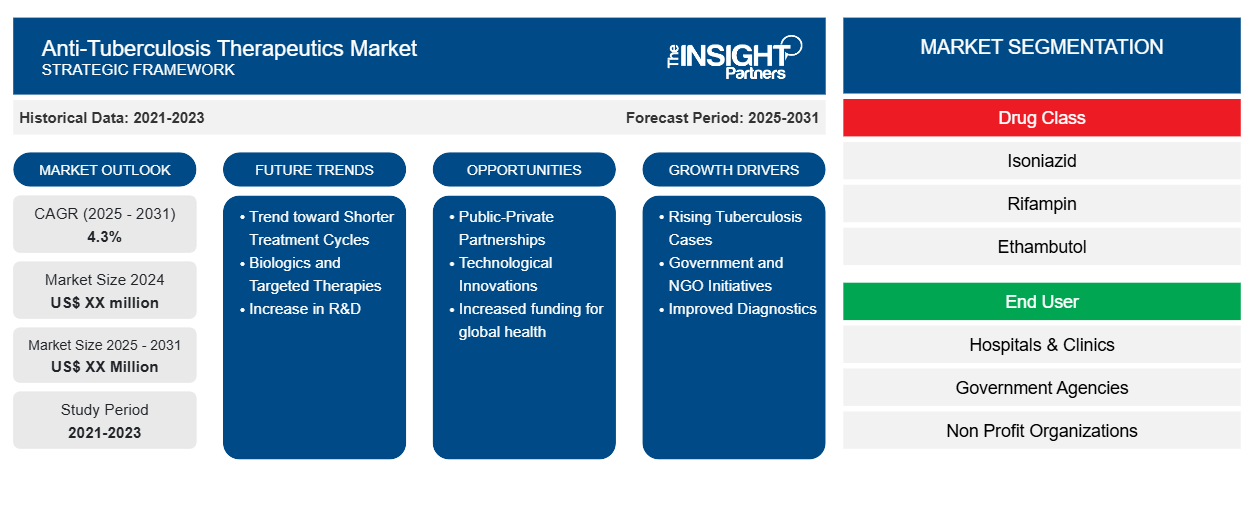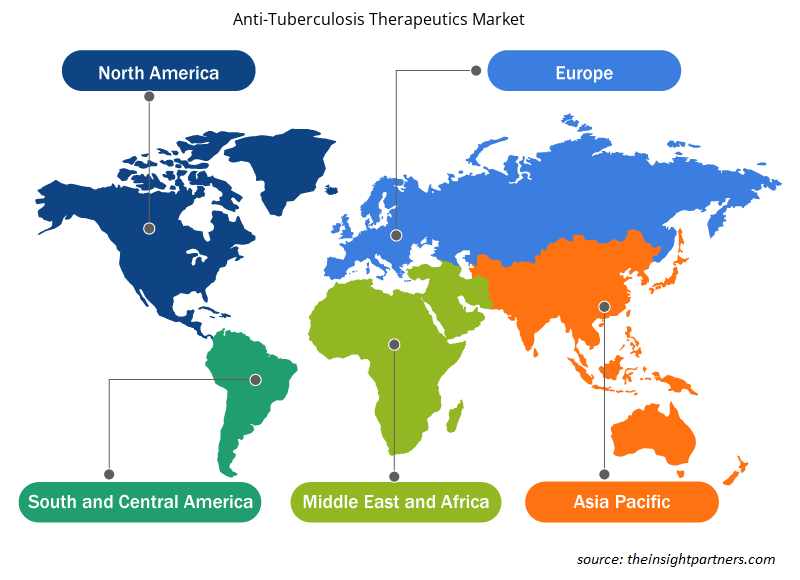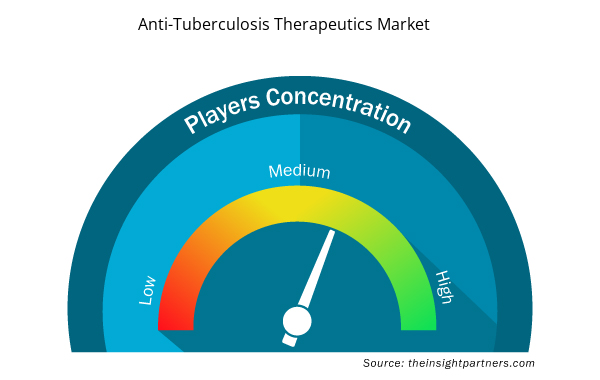The Anti-Tuberculosis Therapeutics Market is expected to register a CAGR of 4.3% from 2025 to 2031, with a market size expanding from US$ XX million in 2024 to US$ XX Million by 2031.
The Anti-Tuberculosis Therapeutics Market report covers analysis by Drug Class (Isoniazid, Rifampin, Ethambutol, Pyrazinamide, Fluoroquinolones, Aminoglycosides, Others); End User (Hospitals & Clinics, Government Agencies, Non Profit Organizations, Others), and Geography (North America, Europe, Asia Pacific, and South and Central America). The global analysis is further broken-down at regional level and major countries. The report Offers the Value in US$ for the above analysis and segments.
Purpose of the Report
The report Anti-Tuberculosis Therapeutics Market by The Insight Partners aims to describe the present landscape and future growth, top driving factors, challenges, and opportunities. This will provide insights to various business stakeholders, such as:
- Technology Providers/Manufacturers: To understand the evolving market dynamics and know the potential growth opportunities, enabling them to make informed strategic decisions.
- Investors: To conduct a comprehensive trend analysis regarding the market growth rate, market financial projections, and opportunities that exist across the value chain.
- Regulatory bodies: To regulate policies and police activities in the market with the aim of minimizing abuse, preserving investor trust and confidence, and upholding the integrity and stability of the market.
Anti-Tuberculosis Therapeutics Market Segmentation
Drug Class
- Isoniazid
- Rifampin
- Ethambutol
- Pyrazinamide
- Fluoroquinolones
- Aminoglycosides
End User
- Hospitals & Clinics
- Government Agencies
- Non Profit Organizations
Customize This Report To Suit Your Requirement
You will get customization on any report - free of charge - including parts of this report, or country-level analysis, Excel Data pack, as well as avail great offers and discounts for start-ups & universities
Anti-Tuberculosis Therapeutics Market: Strategic Insights

- Get Top Key Market Trends of this report.This FREE sample will include data analysis, ranging from market trends to estimates and forecasts.
Anti-Tuberculosis Therapeutics Market Growth Drivers
- Rising Tuberculosis Cases: TB is one of the major infectious diseases globally, especially in areas with less access to health care. Poverty, malnutrition, and overcrowding are factors that increase the number of cases of TB. Moreover, TB often occurs with other health issues such as HIV/AIDS, which complicates treatment and increases the burden of disease. With the disease showing higher rates of transmission in densely populated regions, the demand for anti-TB therapeutics continues to rise globally, especially in high-burden countries in Africa and Asia.
- Government and NGO Initiatives: International efforts to reduce the TB burden are gaining momentum with funding from global organizations such as the WHO, the Global Fund, and national governments. The "End TB Strategy" initiative aims to eradicate the disease through improved diagnostic capabilities, easier access to treatment, and awareness among affected communities. Public-private partnerships have also played a critical role in making anti-TB drugs more affordable and widely available, especially in areas with high infection rates. These efforts have catalyzed substantial investment in research, treatment access, and improved public health responses.
- Improved Diagnostics: Accurate and timely diagnosis of TB is one of the fundamentals for proper TB management. With the advent of new diagnostic technologies, including molecular tests like GeneXpert, and faster liquid culture systems, the ability to detect TB has improved and more resistant strains identified. Diagnostic delay is reduced as treatment is begun sooner, while drug regimens are also rendered more effective. The integration of point-of-care diagnostic tools is especially transformative for rural and remote areas, where traditional diagnostic methods may not be available. As a result, more patients are receiving timely treatment, increasing the need for effective anti-TB therapies.
Anti-Tuberculosis Therapeutics Market Future Trends
- Trend toward Shorter Treatment Cycles: Conventional treatments of TB involve a long period of antibiotics administration of 6–9 months that often do not adhere well in patients. A long period of treatment duration poses a hindrance to proper TB control as many patients are not able to undergo the entire cycle of the drugs, leading to relapses and the generation of resistant strains. Shorter treatment regimens, as tested in the STREAM trials, are promising to reduce the treatment duration without loss of efficacy. The shorter courses will improve compliance, reduce the risk of resistance, and significantly enhance TB treatment outcomes.
- Biologics and Targeted Therapies: While the classical anti-TB drugs act by targeting the bacteria directly, biologics and targeted therapies are a trend in TB drug development. These include monoclonal antibodies, which improve host immunity against TB, and host-directed therapies that boost the host's response against TB with a minimal number of side effects. The drugs target TB in immunocompromised patients and individuals suffering from multidrug-resistant strains of TB. TB treatment is going to be expanded in the coming years with the trend of biologics and personalized medicine, tailoring to the individual-specific needs of the therapy.
- Increase in R&D: The growing threat of MDR-TB and XDR-TB has triggered a significant rise in R&D to discover new treatments. Companies are investing heavily in novel antibiotics and therapies that can combat resistant strains. Combination therapies, where multiple drugs are used together, are also gaining prominence as they help reduce the risk of resistance and improve treatment outcomes. As such, efforts are being put into coming up with inventions like host-directed therapies, which affect the body's immunity to deal with the disease and develop immunity to tackle the resistant strains of TB.
Anti-Tuberculosis Therapeutics Market Opportunities
- Public-Private Partnerships: Public-private partnerships play a growing role in the war against TB. Co-operations involving governments, international organizations, and pharmaceutical companies promote the faster availability of new treatments, enhance access to currently available treatments, and facilitate supply chain logistics in many low-access areas. These partnerships often concentrate on funding research and development, simplifying and improving regulatory pathways, and enhancing healthcare infrastructures. Other examples include joint efforts to expand the scale-up of bedaquiline and delamanid use in TB-endemic countries, thus reaching life-saving drugs to those most in need.
- Technological Innovations: Drug discovery processes have been speeded up by the integration of AI and machine learning. AI also optimizes treatment by improving the efficacy of already established therapies while reducing the harms associated with these treatments. There is also a transforming revolution in the management of TB through mobile health, which is essentially making use of apps that may monitor adherence to treatment or monitor patients' symptoms. Wearable devices that monitor vital signs and detect relapse are further enhancing treatment efficacy and patient outcomes, offering new opportunities for improving the treatment of TB.
- Increased funding for global health: Funding for the fight against TB comes from international health organizations, governments, and philanthropic foundations. The Global Fund and the Gates Foundation are examples of initiatives that are providing the financial resources needed to spur research, improve access to medicines, and strengthen healthcare systems in TB-endemic countries. Growing attention on global health funding is not only accelerating the development of new therapies but also ensuring that these treatments reach those who need them most, opening up market opportunities for pharmaceutical companies focused on TB.
Anti-Tuberculosis Therapeutics Market Regional Insights
The regional trends and factors influencing the Anti-Tuberculosis Therapeutics Market throughout the forecast period have been thoroughly explained by the analysts at Insight Partners. This section also discusses Anti-Tuberculosis Therapeutics Market segments and geography across North America, Europe, Asia Pacific, Middle East and Africa, and South and Central America.

- Get the Regional Specific Data for Anti-Tuberculosis Therapeutics Market
Anti-Tuberculosis Therapeutics Market Report Scope
| Report Attribute | Details |
|---|---|
| Market size in 2024 | US$ XX million |
| Market Size by 2031 | US$ XX Million |
| Global CAGR (2025 - 2031) | 4.3% |
| Historical Data | 2021-2023 |
| Forecast period | 2025-2031 |
| Segments Covered |
By Drug Class
|
| Regions and Countries Covered | North America
|
| Market leaders and key company profiles |
Anti-Tuberculosis Therapeutics Market Players Density: Understanding Its Impact on Business Dynamics
The Anti-Tuberculosis Therapeutics Market market is growing rapidly, driven by increasing end-user demand due to factors such as evolving consumer preferences, technological advancements, and greater awareness of the product's benefits. As demand rises, businesses are expanding their offerings, innovating to meet consumer needs, and capitalizing on emerging trends, which further fuels market growth.
Market players density refers to the distribution of firms or companies operating within a particular market or industry. It indicates how many competitors (market players) are present in a given market space relative to its size or total market value.
Major Companies operating in the Anti-Tuberculosis Therapeutics Market are:
- Macleods Pharmaceuticals Ltd.
- Otsuka Pharmaceutical Co., Ltd.
- Johnson & Johnson Services, Inc.
- Pfizer Inc.
- LUPIN
- Novartis AG
Disclaimer: The companies listed above are not ranked in any particular order.

- Get the Anti-Tuberculosis Therapeutics Market top key players overview
Key Selling Points
- Comprehensive Coverage: The report comprehensively covers the analysis of products, services, types, and end users of the Anti-Tuberculosis Therapeutics Market, providing a holistic landscape.
- Expert Analysis: The report is compiled based on the in-depth understanding of industry experts and analysts.
- Up-to-date Information: The report assures business relevance due to its coverage of recent information and data trends.
- Customization Options: This report can be customized to cater to specific client requirements and suit the business strategies aptly.
The research report on the Anti-Tuberculosis Therapeutics Market can, therefore, help spearhead the trail of decoding and understanding the industry scenario and growth prospects. Although there can be a few valid concerns, the overall benefits of this report tend to outweigh the disadvantages.
- Historical Analysis (2 Years), Base Year, Forecast (7 Years) with CAGR
- PEST and SWOT Analysis
- Market Size Value / Volume - Global, Regional, Country
- Industry and Competitive Landscape
- Excel Dataset


- Health Economics and Outcome Research (HEOR) Services Market
- Precast Concrete Market
- Piling Machines Market
- Batter and Breader Premixes Market
- Virtual Event Software Market
- Truck Refrigeration Market
- Bathroom Vanities Market
- Europe Industrial Chillers Market
- Data Center Cooling Market
- Cosmetic Bioactive Ingredients Market

Report Coverage
Revenue forecast, Company Analysis, Industry landscape, Growth factors, and Trends

Segment Covered
This text is related
to segments covered.

Regional Scope
North America, Europe, Asia Pacific, Middle East & Africa, South & Central America

Country Scope
This text is related
to country scope.
Frequently Asked Questions
The major factors driving the Anti-Tuberculosis Therapeutics Market are Rising Tuberculosis Cases, Government and NGO Initiatives, and Improved Diagnostics
The key future trends of the market are Trend toward Shorter Treatment Cycles, Biologics and Targeted Therapies, and Increase in R&D
The leading players operating in the Anti-Tuberculosis Therapeutics Market include Macleods Pharmaceuticals Ltd., Otsuka Pharmaceutical Co., Ltd., Johnson & Johnson Services, Inc., Pfizer Inc., LUPIN, Novartis AG, AstraZeneca PLC, Eli Lilly And Company, GlaxoSmithKline Plc.
The report can be delivered in PDF/PPT format; we can also share excel dataset based on the request.
Some of the customization options available based on the request are an additional 3–5 company profiles and country-specific analysis of 3–5 countries of your choice. Customizations are to be requested/discussed before making final order confirmation, as our team would review the same and check the feasibility.
Trends and growth analysis reports related to Life Sciences : READ MORE..
1. Macleods Pharmaceuticals Ltd.
2. Otsuka Pharmaceutical Co., Ltd.
3. Johnson & Johnson Services, Inc.
4. Pfizer Inc.
5. LUPIN
6. Novartis AG
7. AstraZeneca PLC
8. Eli Lilly And Company
9. GlaxoSmithKline Plc.
10. Sanofi

 Get Free Sample For
Get Free Sample For